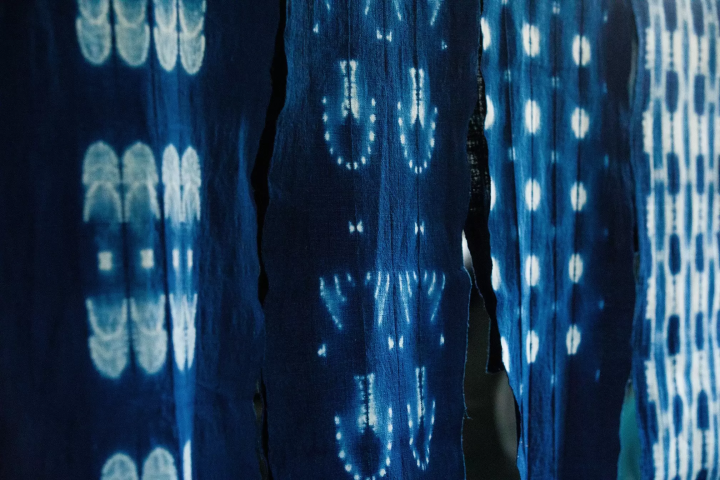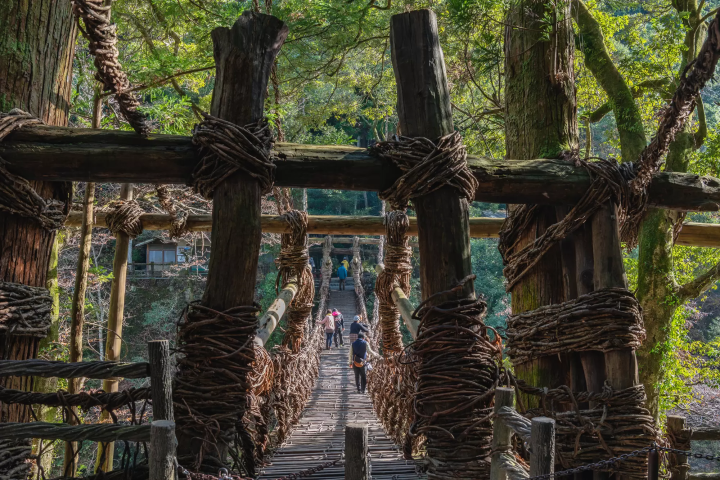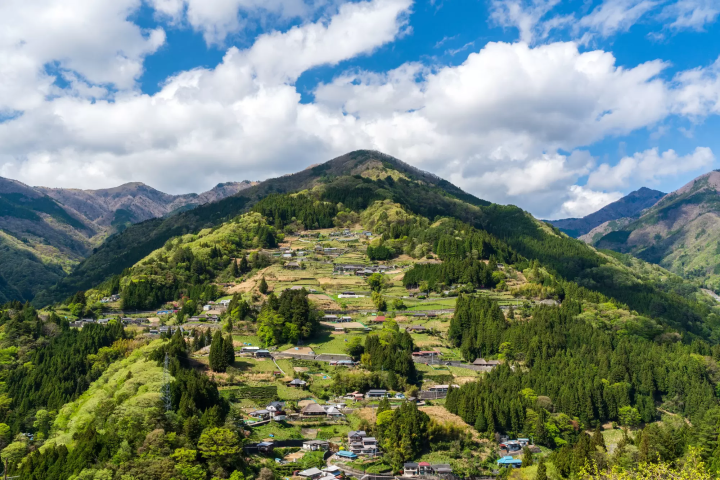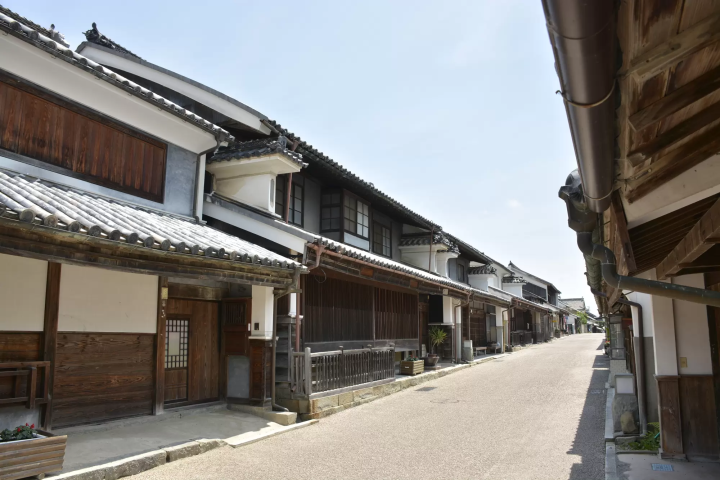Tokushima: Top 12 Things to Do, Scenic Places, Food, and Events

Tokushima, located in Japan's Shikoku region, is famous for its breathtaking natural scenery such as the Naruto Whirlpools and Iya Valley. This guide features 12 famous destinations in Tokushima, things to do, local cuisine, and events such as the exciting Awa Odori festival.
Tokushima: Breathtaking Natural Scenery

Photo by Pixta
Tokushima, a prefecture in Japan's Shikoku region, is a predominantly mountainous region brimming with lush nature and traditional culture.
Tokushima is known for the Naruto Strait whirlpools and the scenic Iya Valley with its Iya Kazurabashi Bridge, one of Japan's three rare bridges made from twisting vines. Awa Odori, a traditional performing art and festival with a history spanning 400 years, is the most famous cultural feature of the region.
Read on to learn about the best places to visit and things to enjoy in Tokushima, alongside cuisine, regional events, and accessibility.
Tokushima: Top 12 Things to Do, Food, and More
1. Naruto Whirlpools
2. Otsuka Museum of Art
3. Ryozenji Temple
4. Awa Odori Hall
5. Ainoyakata: Museum of Indigo Dyeing
6. Oboke and Koboke Gorges
7. Iya Valley
8. Iya Kazurabashi Bridge
9. Ochiai Village
10. Udatsu Townscape
11. Kamiyama: Village with Stylish Traditional Craft Shops
12. Mirai Convenience Store
Tokushima Cuisine
Awa Odori Festival and Other Events
Hotels in Tokushima
Tokushima Access and Transportation
Book the JR Pass for Whole Japan (7, 14, or 21 Days)
Book a hotel room in Tokushima on Booking.com
1. Naruto Whirlpools

Photo by Pixta
The Naruto Strait is known as one of the three greatest tidal currents in the world, along with the Strait of Messina in Italy and the Seymour Narrows in Canada. The strait stretches from Naruto City, Tokushima Prefecture to Minamiawaji City, Hyogo Prefecture.
The strait is acclaimed for the Naruto Whirlpools, a phenomenon that forms vortexes when seawater surges into the water channel.
The whirlpools can reach over 20 meters in diameter. This stunning phenomenon is visible from Uzu no Michi, a walkway built in Onaruto Bridge above the sea, or by taking a boat cruise.
By traveling across the Onaruto Bridge over the Naruto Strait, you'll reach Awaji Island in Hyogo Prefecture on the other side.
Naruto Uzunomichi
Address: Tokushima, Naruto, Narutocho (inside Naruto Park)
Official Website: https://www.uzunomichi.jp/lang_en/
↑ Return to the top of article.
2. Otsuka Museum of Art

Picture courtesy of PR TIMES
The Otsuka Museum of Art is a sightseeing spot in Tokushima that we recommend to art enthusiasts.
View over 1,000 famous Western masterpieces, from ancient murals to modern paintings recreated in their original size. The Sistine Hall is a recreation of the Sistine Chapel's famous ceiling painting by Michelangelo. This masterpiece is the Otsuka Museum of Art's most well-known artwork.
The museum is about a three-minute drive from Uzu no Michi, the viewing spot for the Naruto Whirlpools previously mentioned above. Why not visit both places together during your trip?
Otsuka Museum of Art
Address: Tokushima, Naruto, Narutocho, Tosadomariura Fukuike 65-1
Official Website: https://o-museum.or.jp/
↑ Return to the top of article.
3. Ryozenji Temple

Photo by Pixta
Ryozenji Temple is a Buddhist temple located in Naruto City, Tokushima Prefecture that is known as the starting point for Ohenro.
Ohenro is a famous pilgrimage route where participants pray at 88 Buddhist temples in Shikoku, where Kukai (*) trained 1,200 years ago. These pilgrims are known as "ohenro-san," and anyone can become one.
There are many things to see within the compound of Ryozenji Temple with this history in mind. The main hall is decorated with gorgeous hanging lanterns. There is also a large koi pond, and the Matchmaking Kannon is said to grant luck in love and marriage. Regular visitors can also pray at the temple.
* Kukai (Kobo Daishi): the monk that founded the Shingon sect, a school of Buddhism, and was known for his missionary work in Japan.
Ryozenji Temple
Address: Tokushima, Naruto, Oasacho, Bando Tsukahana 126
Official Website: https://88shikokuhenro.jp/en/jikuwazan-ichijyouin-ryozenji/
↑ Return to the top of article.
4. Awa Odori Hall

Photo by Pixta
Awa Odori is a dance performed annually in August to celebrate one's ancestors. The traditional performing art originated in Tokushima, with a history spanning 400 years since the Edo Period (1600–1868).
Awa Odori Hall is the place to watch live Awa Odori performances year-round.
There's also a museum where you can learn about the history of Awa Odori, a shop stocked with Tokushima souvenirs, and a ropeway station inside Awa Odori Hall. The ropeway will take you to the mountain summit 290 meters above sea level.
Awa Odori Hall
Address: Tokushima, Tokushima, Shinmachibashi 2-20
Official Website: https://www.awaodori-kaikan.jp/ (Japanese)
↑ Return to the top of article.
5. Ainoyakata: Museum of Indigo Dyeing

Picture courtesy of PR TIMES
Aizome is a method of dyeing using a plant dye from Japanese indigo (dyer's knotweed). Many workshops have been in existence in Tokushima, an area suitable for indigo cultivation for centuries. Local artisans have inherited traditional techniques over time.
Ainoyakata is an indigo museum that was the former mansion of an indigo merchant. You can view exhibitions related to indigo dyeing or experience the practice of aizome yourself.
The aizome workshop requires 40 minutes and is available for just 1,000 yen if you choose to indigo-dye a handkerchief. You can bring home your hand-dyed work that same day, making it the perfect souvenir to remember your Tokushima trip.
Historical Museum Ainoyakata
Address: Tokushima, Itano, Aizumicho, Tokumei Maezunishi 172
Official Website: https://ainoyakata.jp/ (Japanese)
↑ Return to the top of article.
6. Oboke and Koboke Gorges

Photo by Pixta
Oboke and Koboke, nationally designated places of scenic beauty, are gorges with a clear running stream between towering crags. The gorges reportedly formed due to river currents over 200 million years, reaching eight kilometers in distance.
There are several ways to enjoy the nature-rich area of Oboke and Koboke. Outdoor activities include rafting, going downstream on a sightseeing boat, or taking a railcar. It takes about an hour and 20 minutes to walk from Oboke Station to Koboke Station, so we also recommend feeling refreshed with a nature-rich hike.
This is a spot where you can experience different charms seasonally. Spring and autumn—when the cherry blossoms and trees begin to change color, respectively—are recommended seasons to visit this area.
Oboke and Koboke Gorges
Address: Tokushima, Miyoshi, Yamashirocho, Shigezane ~ Kamimyo GoogleMap
Official Website: https://miyoshi-tourism.jp/en/spot/oobokekyo-kobokekyo/
↑ Return to the top of article.
7. Iya Valley

Photo by Pixta
Iya Valley is a secluded area in the center of Shikoku Island. Its scenic gorges and steep mountain slopes make it ideal for outdoor activities. Visitors can enjoy staying at a hot spring inn or experiencing the Japanese rural lifestyle in the local villages.
It is believed that Iya Valley was one of the places where the surviving members of the Heike clan took refuge after losing their final battle with the Minamoto clan in 1185, an event that changed the course of Japanese history.

Photo by Pixta
One of the popular features of Iya Valley is the Manneken Pis, a statue created by a Tokushima sculptor situated on a cliff 200 meters above the ground.
It appears to have been inspired by past anecdotes of local children and travelers who would stand on this cliff and put their courage to the test. Please be aware that climbing over the railing to stand on top of the cliff is now prohibited.
Manneken Pis
Address: Tokushima, Miyoshi, Ikedacho, Matsuo GoogleMap
Official Website: https://miyoshi-tourism.jp/en/spot/iyakei-peeingboy/
↑ Return to the top of article.
8. Iya Kazurabashi Bridge

Photo by Pixta
Kazurabashi Bridge, located in the secluded area of Iya, is one of Japan's three rarest bridges with features you won't find anywhere else.
Kazurabashi Bridge is suspended 14 meters over the water, spanning 45 meters long, two meters wide, and weighing six tons. What's more surprising is that the bridge is made of hardy kiwi vines. This bridge is a thrilling experience because it sways each time a person crosses. Moreover, the river is visible through the gaps in the bridge whenever you look down!
The bridge is lit up every night from 19:00 to around 21:30. Enjoy a fantastic atmosphere different from the daytime!
Iya Kazurabashi Bridge
Address: Tokushima, Miyoshi, Nishi-Iyayamamura Zentoku 162-2
Official Website: https://miyoshi-tourism.jp/en/spot/iyanokazurabashi/
↑ Return to the top of article.
9. Ochiai Village

Photo by Pixta
Ochiai Village has maintained its unspoiled and nostalgia-inducing landscape in a small village on the mountain slopes with a population of 100 people.
Private homes and stone walls built after the mid-Edo Period (1650-1750) still exist in this village. The area was also nationally designated as an Important Preservation District for Groups of Traditional Buildings.
The Ochiai Village Observation Spot is located opposite the village and is a great viewing spot that overlooks the entirety of the area.
Ochiai Village
Address: Miyoshi, Higashi-Iya Ochiai
Official Website: https://miyoshi-tourism.jp/en/spot/ochiaishuraku/
↑ Return to the top of article.
10. Udatsu Townscape

Photo by Pixta
The Udatsu Townscape in the town of Waki, Tokushima has an air of elegance, almost like you've slipped back in time to the Edo Period (1600-1868).
Udatsu refers to an extended wall decorating the roof of a house for fire prevention. The Waki area became known as the Udatsu Townscape because of the many residences with udatsu that presently remain there.
Of course, you should take a walk around town. We also recommend trying the local cuisine at a cafe inside the Mima Tourism Exchange Center (Japanese), a tourism complex renovated from an old Japanese home. You can also try your hand at an aizome (indigo dyeing) workshop.
Udatsu Townscape
Address: Tokushima, Mima, Wakimachi, Oaza Wakimachi 2
Official Website: https://www.city.mima.lg.jp/kanko/map/list/11506.html (Japanese)
↑ Return to the top of article.
11. Kamiyama: Village with Stylish Traditional Craft Shops
Kamiyama is a nature-rich town in central Tokushima Prefecture. It faced the dangers of depopulation for quite some time due to population decline. However, it currently is in the spotlight with IT corporate offices and new residents thanks to regional revitalization efforts.
Trendy shops have opened in the past few years in Kamiyama. Shops like SHIZQ, a supplier of stylish products made from cedar wood, and Mamechiyo COFFEE ROASTERY (Japanese), who sell coffee beans roasted in-house, are the perfect places for buying wonderful souvenirs! Michinoeki Onsen no Sato Kamiyama (Japanese), a market that carries local specialties, is another recommended spot in town.
Kamiyama
Address: Tokushima, Myozai, Kamiyamacho
Official Website: https://www.town.kamiyama.lg.jp/english-pages/
↑ Return to the top of article.
12. Mirai Convenience Store

Picture courtesy of PR TIMES
Mirai Convenience Store is currently trending in Tokushima. This convenience store's concept is to be "the world's most beautiful convenience store."
The store can be found in Kito, dubbed the "Tibet of Shikoku" due to the surrounding mountains exceeding 1,000 meters in Naka, Tokushima. Its beautiful architecture is immediately recognizable, receiving many design awards since opening in 2020.
Your daily convenience store items can be purchased here. Stop at the cafe next door to taste menu items made with fresh, local Kito Yuzu (citrus fruit).
Mirai Convenience Store
Address: Tokushima, Naka, Naka, Kitokitagawa Imojiyashiki 11-1
Official Website: https://mirai-cvs.jp/en/
↑ Return to the top of article.
Tokushima Cuisine

Picture courtesy of Pixta
While sightseeing, we highly recommend trying local cuisine unique to the area.
Tokushima ramen—the soul food of Tokushima Prefecture—is an easily enjoyable dish. It has roots in the ramen soup offered at food stalls after World War II (following 1945) and is divided into three types: brown for a soy sauce and pork bone-based broth, yellow for chicken broth, and white for a light broth. Tokushima ramen is characterized by serving pork belly instead of char siu pork and a raw egg.
There are other local dishes unique to Tokushima. Some prime examples include yakitori (skewered chicken) made with Awaodori chicken, a specialty of Tokushima Prefecture, Iya soba made from 100% buckwheat flour harvested in the secluded area of Iya, and desserts containing Naruto kintoki, a sweet potato variety that grows in the Naruto area.
↑ Return to the top of article.
Awa Odori Festival and Other Events
Next, we'll introduce seasonal events you can attend to fully appreciate Tokushima's traditional culture and nature.
The Awa Odori Festival (Japanese) features a traditional performing art from Tokushima with a 400-year history, making it the prefecture's most famous and largest summer event. The spectacular festivity has 100,000 dancers that parade down the streets accompanied by Japanese musical instruments. In fact, it is one of Japan's Big Three Bon Odori (*2) Festivals.
Big Hina Matsuri (Japanese) is a famous hina matsuri (*3) event held annually in spring from February to March in Katsuura, Tokushima. Hundreds of hina dolls are magnificently displayed during the festivities on a massive eight-meter-tall doll stand.
*2 Bon Matsuri: a festival held every year in August to welcome and pray for the spirits of one's ancestors.
*3 Hina Matsuri: a festival held every year on March 3rd to wish for the healthy growth of daughters.

Picture courtesy of Pixta
Yaoyorozu no Kami no Goten (Japanese), located about a 12-minute drive from the Udatsu Townscape, is one of the best flower-viewing spots in Tokushima. Every spring from late March to early April, when the cherry blossoms are at their peak, a spectacular site appears with the entire mountain covered in 8,000 cherry trees.
We also recommend visiting Konosekyo Gorge, a scenic spot for autumn foliage, from late October to mid-November.
Read also
↑ Return to the top of article.
Hotels in Tokushima

Picture courtesy of Booking.com
Hotel Kazurabashi is our recommendation for those eager to make unforgettable memories in Tokushima.
This hotel is near Kazurabashi Bridge, the seventh spot introduced in this article. A free shuttle bus is available for guests from the hotel to see the bridge illuminated at night. Additionally, guests can spend a luxurious time in the Tenku Open-Air Bath, which is accessible by a cable car inside the hotel while admiring the beautiful scenery of the valley.
Want to go on a trip around Shikoku? Then we recommend JR Hotel Clement Tokushima for its convenient and direct access to JR Tokushima Station.
Reserve Hotel Kazurabashi on Booking.com!
↑ Return to the top of article.
Tokushima Access and Transportation
How to Access Tokushima from Tokyo
There are three main ways to access Tokushima from Tokyo—by airplane, railway (Shinkansen bullet train + limited express train), or express bus.
Do you value speed during your travels? Then we recommend traveling by airplane, which only requires an hour and 10 minutes. Prefer snagging deals and low prices? Then we suggest taking an express bus to access the prefecture for around 7,000 yen.
How to Access Tokushima from Kansai
What if you're traveling to Tokushima Prefecture from the Kansai region, which includes Osaka, Kyoto, and Kobe? Traveling to Tokushima via Awaji Island in Hyogo Prefecture is the standard method.
In this scenario, there are mainly two ways to access the prefecture: by car (rental car) or express bus.
An express bus will arrive at your destination in 3.5 hours from Osaka, three hours from Kyoto, and two hours from Kobe.
Want more freedom while traveling? Then we also advise reserving a rental car. MATCHA offers a 10% discount coupon when renting a vehicle from Nippon Rent-A-Car, a famous car rental company in Japan. Please consider using this coupon on your next rental (*)!
*Since demand has surged in the past few years, rental cars may be unavailable due to a shortage of vehicles.

Click Here to Receive 10% Off Nippon Rent-A-Car!
↑ Return to the top of article.
Have Fun Exploring Tokushima
There are many locations where you can experience traditional culture and nature in Tokushima.
The seasonal charms of Tokushima are visible year-round, with cherry blossoms in the spring, the Awa Odori Festival in the summer, to the changing colors of the leaves in the autumn!
Read also
Main image by Pixta
I’ve been working as a travel editor and writer for seven years and joined the MATCHA team in 2022. Originally from Tokyo, I studied abroad in San Jose during college. It's always exciting to find "hidden gems" in Japan by looking at my home country from a traveler's perspective!
Things I love: Strolling around town, coffee, art, movies, and trips
Top spots: Shinjuku Gyoen, Isshiki Beach, and Mt. Aso in Kumamoto







![[2026] Top 5 Strawberry Picking Spots in Tokushima, Naruto| Farms and Access Guide for January to May](https://resources.matcha-jp.com/resize/720x2000/2025/03/06-227165.webp)


























![[Coupon Available] Attention Overseas Winter Sports Fans! Nagano's Sports Depot Has Evolved](https://resources.matcha-jp.com/resize/720x2000/2026/01/05-254819.webp)
![[2 hours from Tokyo ] 10 Quiet and Breathtaking Views of Mount Fuji in Yamanashi Hokuto City , Yamanashi - Part 2](https://resources.matcha-jp.com/resize/720x2000/2025/12/16-253037.webp)

![[Reopening in March 2026] Ikoma Sanjo Amusement Park Park, 45 minutes from Osaka , with free admission](https://resources.matcha-jp.com/resize/720x2000/2024/08/28-194409.webp)